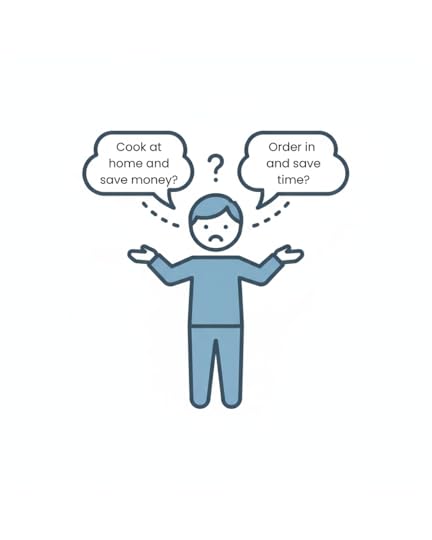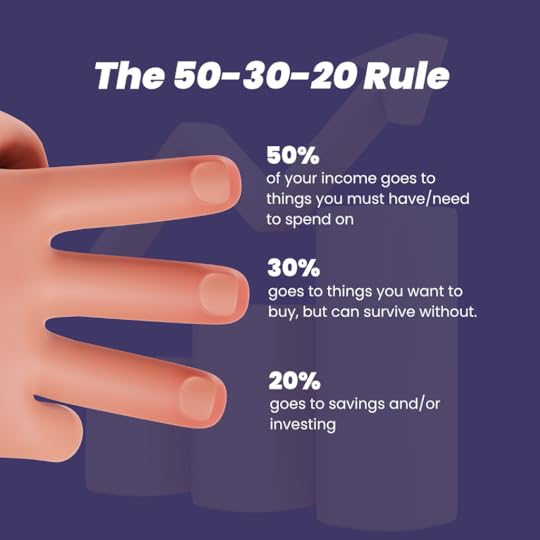Think in Percentages, Not Digits: The Psychology of Money
Here’s the truth about money management that most financial advice misses: your brain processes $200 and 6% of your income completely differently. One feels like a hard number you can’t change. The other feels like a choice you control.
This isn’t just financial semantics. It’s the difference between budgeting success and another abandoned spreadsheet in your Downloads folder. When you shift from thinking “$1,500 for rent” to “45% of my income for housing,” something fundamental changes in how you make money decisions. You stop managing dollars and start managing your financial life.
 The Problem with Dollar-Based Thinking
The Problem with Dollar-Based ThinkingMost people know exactly what they pay for rent. Ask them how much they spend on ‘convenience’ — DoorDash fees, Uber rides, last-minute Target runs — and they have no idea.
Here’s the disconnect: A $6 delivery fee feels annoying but acceptable. But that same person would never consciously budget $180/month for ‘convenience expenses,’ even though that’s exactly what they’re spending.
This is your brain on dollar-based thinking. Every purchase exists in isolation. $6 feels like a small premium for not leaving the house. $180 (what those delivery fees actually cost monthly) feels like real money. But 4.5% of a $4,000 monthly income? That puts the real cost in perspective.
Mental accounting, a concept developed by Nobel Prize-winning economist Richard Thaler, explains why we do this. We create separate “buckets” for different types of spending, treating money differently based on how we categorize it. The $6 fee goes in the “convenience charge” bucket. The $180 would go in the “that could be a savings contribution” bucket. Same money, different mental treatment.
Research consistently shows that people struggle with this disconnect. A study published in the Journal of Consumer Research found that consumers provide dramatically different evaluations of the same quantity when presented as absolute numbers versus percentages. We’re literally wired to process these formats differently.
 Photo by Declan Sun on Unsplash
Photo by Declan Sun on UnsplashWhy Percentages Change Everything
That $15 streaming subscription isn’t just $15 — it’s a specific slice of your financial pie. And that slice might be bigger than you think.
Let’s say you earn $4,000 monthly after taxes. Here’s how percentage thinking transforms common decisions:
Traditional thinking: “I’ll save $400 this month.”
Percentage thinking: “I’m saving 10% of my income this month.”
The percentage version automatically scales with your income. Get a raise? Your savings grows proportionally. Take a pay cut? Your savings adjusts without breaking your budget. The percentage becomes a flexible framework, not a rigid target.
This psychological shift affects everything from spending to investing. Behavioral finance research shows that people who think in relative terms (percentages) rather than absolute terms (dollars) make more rational financial decisions over time. They’re less likely to be swayed by the psychological tricks our brains play on us.
The Science Behind Percentage PsychologyOur brains aren’t built for modern financial complexity. They evolved to handle immediate, concrete trade-offs — like choosing between hunting and gathering. Abstract concepts like compound interest or long-term budgeting? Those require conscious effort to process.
This is where percentage thinking becomes powerful. It transforms abstract money decisions into relational ones. Instead of asking “Can I afford this $300 purchase?” you ask “Is this worth 7.5% of my monthly income?” The second question forces you to consider opportunity cost — what else that 7.5% could do for you. When you start THINKING in percentages, everything starts having a relative value. Does this purchase feel worth 7.5% of my income this month? How long will I really use it? Would it make me happy/make my life easier/better? They all start becoming clearer.
“Dr. Daniel Kahneman’s research on behavioral economics reveals something fascinating: people instinctively think in percentages, even when they don’t realize it. We’ll drive across town to save $10 on a $50 purchase (20% savings) but won’t make the same drive to save $10 on a $500 purchase (2% savings). Same time, same gas, same $10 — but our brains automatically calculate the percentage.
The psychological principle at work here is called “anchoring.” When you anchor your spending decisions to percentages rather than dollar amounts, you create a more flexible and rational framework for financial choices. You’re less likely to fall into the mental accounting traps that derail most budgets.
Real-World Examples: Percentage Thinking in Action
Let’s walk through how this works with actual money decisions Americans face every day.
Example 1: The Emergency Fund
Traditional advice says “save $10,000 for emergencies.”
But that number means nothing without context — for someone earning $50K, that’s 20% of their income.
Instead, think in proportions: aim for 3–6 months of expenses and build it gradually.
You don’t need to save it all at once — just adjust your percentages.
Maybe this month you dial back dining out, freeing up 5% from your monthly income, and add that to your emergency fund. Over time, your cushion grows with your income and discipline.
Example 2: Housing Decisions
The classic rule is “don’t spend more than 30% on housing.” This isn’t just a random percentage — it’s based on what proportion of income can sustainably go toward shelter while leaving room for other necessities and savings. Someone earning $60,000 annually has a $1,500 monthly housing budget. Someone earning $100,000 has $2,500. Same percentage, different lifestyles, both sustainable.
Example 3: Retirement Savings
Finance experts recommend saving 10–15% for retirement. This percentage scales with your income throughout your career. Early in your career, 10% of $40,000 is $4,000 annually. Later, 10% of $80,000 is $8,000. The percentage stays constant, but your actual retirement security grows with your earning power.
 The 50/30/20 Rule: Percentage Budgeting in Practice
The 50/30/20 Rule: Percentage Budgeting in PracticeThe most successful simple budgeting framework in America proves the power of percentage thinking: the 50/30/20 rule. Spend 50% on needs, 30% on wants, 20% on savings and debt repayment.
This rule works because it’s proportional. Someone earning $3,000 monthly after taxes has $1,500 for needs, $900 for wants, and $600 for savings. Someone earning $6,000 has $3,000, $1,800, and $1,200 respectively. Both people have the same financial balance, just at different scales.
Research on budgeting effectiveness shows that people who use percentage-based budgeting systems have significantly higher adherence rates than those using fixed dollar amounts. The flexibility built into percentage thinking accommodates income changes, seasonal variations, and life transitions without requiring complete budget overhauls.
The psychological benefits are clear:
· Scalability: Your budget grows with your income
· Flexibility: Percentages adapt to life changes
· Perspective: Relative thinking reveals true costs
· Sustainability: Proportional systems feel less restrictive
Breaking Down Mental Money Barriers
The biggest barrier to percentage thinking isn’t mathematical — it’s psychological. We’re conditioned to think in absolute terms because that’s how we experience money day-to-day. Your rent is $1,200, not “36% of income.” Your coffee costs $4, not “0.1% of daily earnings.”
But this conditioning works against our financial best interests. Mental accounting research shows that people who maintain rigid dollar-based categories often struggle when circumstances change. The person with a “$200 entertainment budget” doesn’t know what to do when they get a raise. The person with a “5% entertainment allocation” automatically adjusts.
Here’s how to make the mental shift:
Start with major categories first. Calculate what percentage of your after-tax income currently goes to housing, food, transportation, and savings. Most people are shocked by these numbers. Housing eating up 45% of your income? That’s not a “$1,500 rent problem” — it’s a “lifestyle sustainability problem.”
Use percentages for financial goals. Instead of “save $500 monthly,” commit to “save 15% of income.” Instead of “pay off $10,000 in debt,” focus on “allocate 10% to debt repayment.” The percentage framework makes goals feel more achievable and automatically adjusts to income changes.
Apply the percentage test to purchases. Before any significant purchase, calculate what percentage of your monthly income it represents. That $800 weekend trip might be reasonable at 8% of monthly income but painful at 20%. The percentage reveals the real cost.
Action Steps: Implementing Percentage-Based Budgeting
Step 1: Calculate Your Current Percentages
Pull up last month’s expenses and calculate what percentage of your after-tax income went to each major category. Use broad categories: housing, food, transportation, entertainment, debt payments, savings, other. Don’t get caught up in precise tracking — you want the big picture.
Step 2: Compare Against Benchmarks
How do your percentages compare to recommended guidelines? Housing should be under 30%, total debt payments under 20%, savings at least 20%. If you’re way off, you’ve identified your priority areas for adjustment.
Step 3: Set Percentage Goals
Choose percentage targets for each category based on your financial priorities and life circumstances. Someone in an expensive city might allocate 35% to housing and 25% to savings. Someone paying off debt might use 25% for debt repayment and 15% for savings temporarily.
Step 4: Automate the System
Set up automatic transfers based on your percentage allocations. When your paycheck hits your account, predetermined percentages automatically flow to different accounts: checking for needs, savings for future goals, separate account for wants. This removes daily decision-making from the process.
Step 5: Review and Adjust Quarterly
Every three months, recalculate your percentages based on actual spending and any income changes. The beauty of percentage budgeting is that small adjustments keep you on track without major overhauls.
Why This Matters for Your Financial Future
Percentage thinking isn’t just about budgeting — it’s about building a sustainable relationship with money. When you think proportionally, you make decisions that scale with your financial reality. You’re less likely to lifestyle inflate your way into financial stress. You’re more likely to maintain consistent savings rates as your income grows.
This psychological shift also protects you from common financial mistakes. You won’t blow a tax refund because you understand it’s just a percentage of your annual income returned to you. You won’t panic about a $500 car repair because you know it represents a manageable percentage of your emergency fund.
Most importantly, percentage thinking gives you control. Instead of feeling like money just “disappears,” you’re actively choosing how to allocate your financial resources. You’re not managing dollars — you’re managing your priorities.
At Cent Capital, we see this transformation regularly. People who shift from dollar-based to percentage-based thinking report feeling more in control of their finances, even when their income situations haven’t changed. The framework gives them clarity and confidence in their financial decisions.
The bottom line: Your brain already thinks in percentages for most life decisions. You don’t eat “exactly 1,200 calories” — you eat until you’re satisfied, which is roughly a percentage of your hunger. You don’t sleep “exactly 8 hours” — you sleep a proportion of your day that feels right.
Apply the same natural thinking to money, and watch your financial stress decrease while your financial progress accelerates. Think in percentages, not digits. Your future self will thank you.
Want to explore percentage-based budgeting tools and automated savings strategies? Check out cent.capital for practical financial management resources designed for real people with real financial goals.
[image error]Future of Finance & Technology
- Shivam Singh's profile
- 15 followers



